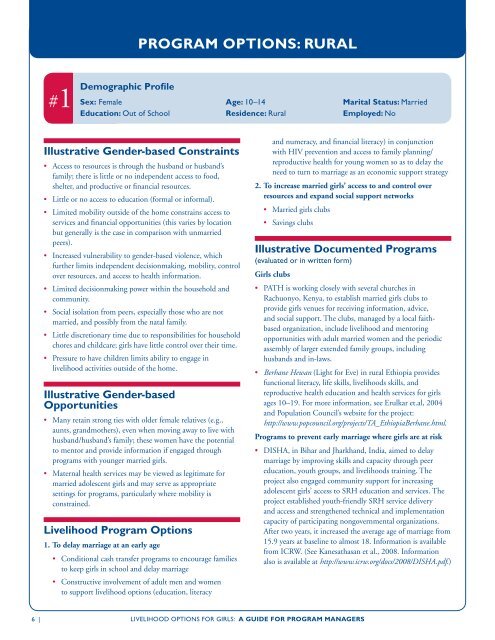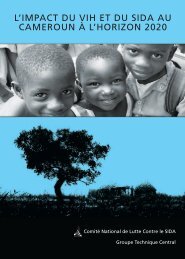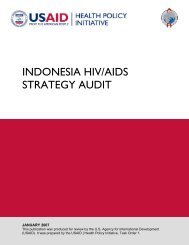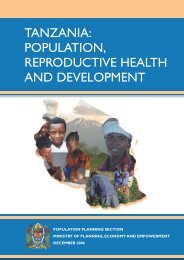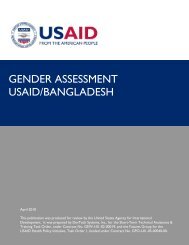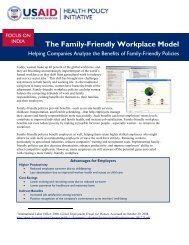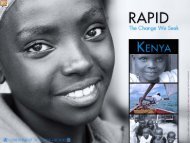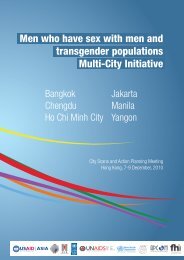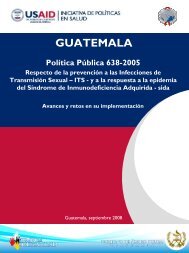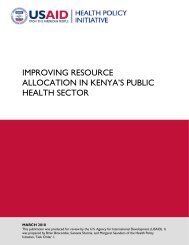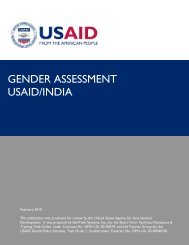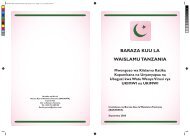LIVELIHOOD OPTIONS FOR GIRLS: - Health Policy Initiative
LIVELIHOOD OPTIONS FOR GIRLS: - Health Policy Initiative
LIVELIHOOD OPTIONS FOR GIRLS: - Health Policy Initiative
- No tags were found...
Create successful ePaper yourself
Turn your PDF publications into a flip-book with our unique Google optimized e-Paper software.
PROGRAM <strong>OPTIONS</strong>: RURAL1Demographic Profile# Sex: Female Age: 10–14 Marital Status: MarriedEducation: Out of School Residence: Rural Employed: Noand numeracy, and financial literacy) in conjunctionIllustrative Gender-based Constraints with HIV prevention and access to family planning/reproductive health for young women so as to delay the• Access to resources is through the husband or husband’sneed to turn to marriage as an economic support strategyfamily; there is little or no independent access to food, shelter, and productive or financial resources.2. To increase married girls’ access to and control over • Little or no access to education (formal or informal).resources and expand social support networks• Limited mobility outside of the home constrains access to • Married girls clubsservices and financial opportunities (this varies by location • Savings clubsbut generally is the case in comparison with unmarriedpeers).Illustrative Documented Programs• Increased vulnerability to gender-based violence, which(evaluated or in written form)further limits independent decisionmaking, mobility, control over resources, and access to health information.Girls clubs • Limited decisionmaking power within the household and • PATH is working closely with several churches incommunity.Rachuonyo, Kenya, to establish married girls clubs to • Social isolation from peers, especially those who are notprovide girls venues for receiving information, advice, married, and possibly from the natal family.and social support. The clubs, managed by a local faith-based organization, include livelihood and mentoring• Little discretionary time due to responsibilities for householdopportunities with adult married women and the periodicchores and childcare; girls have little control over their time.assembly of larger extended family groups, including• Pressure to have children limits ability to engage inhusbands and in-laws.livelihood activities outside of the home.• Berhane Hewan (Light for Eve) in rural Ethiopia providesfunctional literacy, life skills, livelihoods skills, andIllustrative Gender-basedreproductive health education and health services for girlsOpportunitiesages 10–19. For more information, see Erulkar et.al, 2004and Population Council’s website for the project:• Many retain strong ties with older female relatives (e.g., http://www.popcouncil.org/projects/TA_EthiopiaBerhane.html.aunts, grandmothers), even when moving away to live withhusband/husband’s family; these women have the potential Programs to prevent early marriage where girls are at riskto mentor and provide information if engaged through • DISHA, in Bihar and Jharkhand, India, aimed to delay programs with younger married girls.marriage by improving skills and capacity through peer • Maternal health services may be viewed as legitimate for education, youth groups, and livelihoods training. Themarried adolescent girls and may serve as appropriateproject also engaged community support for increasingsettings for programs, particularly where mobility is adolescent girls’ access to SRH education and services. Theconstrained.project established youth-friendly SRH service delivery and access and strengthened technical and implementationLivelihood Program Optionscapacity of participating nongovernmental organizations.After two years, it increased the average age of marriage from1. To delay marriage at an early age15.9 years at baseline to almost 18. Information is availablefrom ICRW. (See Kanesathasan et al., 2008. Information• Conditional cash transfer programs to encourage families also is available at http://www.icrw.org/docs/2008/DISHA.pdf.)to keep girls in school and delay marriage• Constructive involvement of adult men and women to support livelihood options (education, literacy 6 | <strong>LIVELIHOOD</strong> <strong>OPTIONS</strong> <strong>FOR</strong> <strong>GIRLS</strong>: A GUIDE <strong>FOR</strong> PROGRAM MANAGERS


